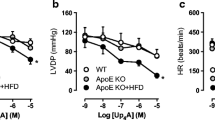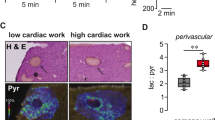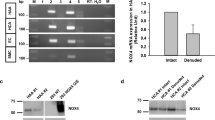Abstract
Adenosine increases coronary flow mainly through the activation of A2A and A2B adenosine receptors (ARs). However, the mechanisms for the regulation of coronary flow are not fully understood. We previously demonstrated that adenosine-induced increase in coronary flow is in part through NADPH oxidase (Nox) activation, which is independent of activation of either A1 or A3ARs. In this study, we hypothesize that adenosine-mediated increase in coronary flow through Nox activation depends on A2A but not A2BARs. Functional studies were conducted using isolated Langendorff-perfused mouse hearts. Hydrogen peroxide (H2O2) production was measured in isolated coronary arteries from WT, A2AAR knockout (KO), and A2BAR KO mice using dichlorofluorescein immunofluorescence. Adenosine-induced concentration-dependent increase in coronary flow was attenuated by the specific Nox2 inhibitor gp91 ds-tat or reactive oxygen species (ROS) scavenger EUK134 in both WT and A2B but not A2AAR KO isolated hearts. Similarly, the A2AAR selective agonist CGS-21680-induced increase in coronary flow was significantly blunted by Nox2 inhibition in both WT and A2BAR KO, while the A2BAR selective agonist BAY 60-6583-induced increase in coronary flow was not affected by Nox2 inhibition in WT. In intact isolated coronary arteries, adenosine-induced (10 μM) increase in H2O2 formation in both WT and A2BAR KO mice was attenuated by Nox2 inhibition, whereas adenosine failed to increase H2O2 production in A2AAR KO mice. In conclusion, adenosine-induced increase in coronary flow is partially mediated by Nox2-derived H2O2, which critically depends upon the presence of A2AAR.





Similar content being viewed by others
References
Feigl EO (1983) Coronary physiology. Physiol Rev 63(1):1–205
Duncker DJ, Bache RJ, Merkus D (2012) Regulation of coronary resistance vessel tone in response to exercise. J Mol Cell Cardiol 52(4):802–813
Duncker DJ, Bache RJ (2008) Regulation of coronary blood flow during exercise. Physiol Rev 88(3):1009–1086
Durand MJ, Gutterman DD (2013) Diversity in mechanisms of endothelium-dependent vasodilation in health and disease. Microcirculation 20(3):239–247
Deussen A, Ohanyan V, Jannasch A, Yin L, Chilian W (2012) Mechanisms of metabolic coronary flow regulation. J Mol Cell Cardiol 52(4):794–801
Zhou Z, de Beer VJ, Bender SB, Jan Danser AH, Merkus D, Laughlin MH, Duncker DJ (2014) Phosphodiesterase-5 activity exerts a coronary vasoconstrictor influence in awake swine that is mediated in part via an increase in endothelin production. Am J Physiol Heart Circ Physiol 306(6):H918–927
Berne RM (1963) Cardiac nucleotides in hypoxia: possible role in regulation of coronary blood flow. Am J Physiol 204:317–322
Tune JD, Gorman MW (1985) Feigl EO (2004) Matching coronary blood flow to myocardial oxygen consumption. J Appl Physiol 97(1):404–415
Mustafa SJ, Morrison RR, Teng B, Pelleg A (2009) Adenosine receptors and the heart: role in regulation of coronary blood flow and cardiac electrophysiology. Handb Exp Pharmacol 193:161–188
Duncker DJ, Stubenitsky R, Verdouw PD (1998) Role of adenosine in the regulation of coronary blood flow in swine at rest and during treadmill exercise. Am J Physiol 275(5 Pt 2):H1663–1672
Edlund A, Conradsson T, Sollevi A (1995) A role for adenosine in coronary vasoregulation in man. Effects of theophylline and enprofylline. Clin Physiol 15(6):623–636
Burnstock G, Ralevic V (2014) Purinergic signaling and blood vessels in health and disease. Pharmacol Rev 66(1):102–192
Headrick JP, Ashton KJ, Rose'meyer RB, Peart JN (2013) Cardiovascular adenosine receptors: expression, actions and interactions. Pharmacol Ther 140(1):92–111
Flood A, Headrick JP (2001) Functional characterization of coronary vascular adenosine receptors in the mouse. Br J Pharmacol 133(7):1063–1072
Sato A, Terata K, Miura H, Toyama K, Loberiza FR Jr, Hatoum OA, Saito T, Sakuma I, Gutterman DD (2005) Mechanism of vasodilation to adenosine in coronary arterioles from patients with heart disease. Am J Physiol Heart Circ Physiol 288(4):H1633–1640
Sanjani MS, Teng B, Krahn T, Tilley S, Ledent C, Mustafa SJ (2011) Contributions of A2A and A2B adenosine receptors in coronary flow responses in relation to the KATP channel using A2B and A2A/2B double-knockout mice. Am J Physiol Heart Circ Physiol 301(6):H2322–2333
Talukder MA, Morrison RR, Jacobson MA, Jacobson KA, Ledent C, Mustafa SJ (2002) Targeted deletion of adenosine A(3) receptors augments adenosine-induced coronary flow in isolated mouse heart. Am J Physiol Heart Circ Physiol 282(6):H2183–2189
Tawfik HE, Teng B, Morrison RR, Schnermann J, Mustafa SJ (2006) Role of A1 adenosine receptor in the regulation of coronary flow. Am J Physiol Heart Circ Physiol 291(1):H467–472
Zhou X, Teng B, Tilley S, Ledent C, Mustafa SJ (2014) Metabolic hyperemia requires ATP-sensitive K+ channels and H2O2 but not adenosine in isolated mouse hearts. Am J Physiol Heart Circ Physiol 307(7):H1046–1055
Teng B, Ledent C, Mustafa SJ (2008) Up-regulation of A2B adenosine receptor in A2A adenosine receptor knockout mouse coronary artery. J Mol Cell Cardiol 44(5):905–914
Fredholm BB, Arslan G, Halldner L, Kull B, Schulte G, Wasserman W (2000) Structure and function of adenosine receptors and their genes. Naunyn Schmiedebergs Arch Pharmacol 362(4-5):364–374
Liu Y, Bubolz AH, Mendoza S, Zhang DX, Gutterman DD (2011) H2O2 is the transferrable factor mediating flow-induced dilation in human coronary arterioles. Circ Res 108(5):566–573
Rogers PA, Dick GM, Knudson JD, Focardi M, Bratz IN, Swafford AN Jr, Saitoh S, Tune JD, Chilian WM (2006) H2O2-induced redox-sensitive coronary vasodilation is mediated by 4-aminopyridine-sensitive K+ channels. Am J Physiol Heart Circ Physiol 291(5):H2473–2482
Yada T, Shimokawa H, Hiramatsu O, Kajita T, Shigeto F, Goto M, Ogasawara Y, Kajiya F (2003) Hydrogen peroxide, an endogenous endothelium-derived hyperpolarizing factor, plays an important role in coronary autoregulation in vivo. Circulation 107(7):1040–1045
Owen MK, Witzmann FA, McKenney ML, Lai X, Berwick ZC, Moberly SP, Alloosh M, Sturek M, Tune JD (2013) Perivascular adipose tissue potentiates contraction of coronary vascular smooth muscle: influence of obesity. Circulation 128(1):9–18
Yada T, Shimokawa H, Hiramatsu O, Shinozaki Y, Mori H, Goto M, Ogasawara Y, Kajiya F (2007) Important role of endogenous hydrogen peroxide in pacing-induced metabolic coronary vasodilation in dogs in vivo. J Am Coll Cardiol 50(13):1272–1278
Takac I, Schroder K, Brandes RP (2012) The Nox family of NADPH oxidases: friend or foe of the vascular system? Curr Hypertens Rep 14(1):70–78
Amanso AM, Griendling KK (2012) Differential roles of NADPH oxidases in vascular physiology and pathophysiology. Front Biosci (Schol Ed) 4:1044–1064
Frazziano G, Champion HC, Pagano PJ (2012) NADPH oxidase-derived ROS and the regulation of pulmonary vessel tone. Am J Physiol Heart Circ Physiol 302(11):H2166–2177
Schroder K (2010) Isoform specific functions of Nox protein-derived reactive oxygen species in the vasculature. Curr Opin Pharmacol 10(2):122–126
Taverne YJ, Bogers AJ, Duncker DJ, Merkus D (2013) Reactive oxygen species and the cardiovascular system. Oxid Med Cell Longev 2013:862423
Larsen BT, Bubolz AH, Mendoza SA, Pritchard KA Jr, Gutterman DD (2009) Bradykinin-induced dilation of human coronary arterioles requires NADPH oxidase-derived reactive oxygen species. Arterioscler Thromb Vasc Biol 29(5):739–745
El-Awady MS, Ansari HR, Fil D, Tilley SL, Mustafa SJ (2011) NADPH oxidase pathway is involved in aortic contraction induced by A3 adenosine receptor in mice. J Pharmacol Exp Ther 338(2):711–717
Carlstrom M, Lai EY, Ma Z, Patzak A, Brown RD, Persson AE (2009) Role of NOX2 in the regulation of afferent arteriole responsiveness. Am J Physiol Regul Integr Comp Physiol 296(1):R72–79
Gebremedhin D, Weinberger B, Lourim D, Harder DR (2010) Adenosine can mediate its actions through generation of reactive oxygen species. J Cereb Blood Flow Metab 30(10):1777–1790
Narayan P, Mentzer RM Jr, Lasley RD (2001) Adenosine A1 receptor activation reduces reactive oxygen species and attenuates stunning in ventricular myocytes. J Mol Cell Cardiol 33(1):121–129
El-Awady MS, Rajamani U, Teng B, Tilley SL, Mustafa SJ (2013) Evidence for the involvement of NADPH oxidase in adenosine receptors-mediated control of coronary flow using A and A knockout mice. Physiol Rep 1(3), e00070
Sharifi-Sanjani M, Zhou X, Asano S, Tilley S, Ledent C, Teng B, Dick GM, Mustafa SJ (2013) Interactions between A(2A) adenosine receptors, hydrogen peroxide, and KATP channels in coronary reactive hyperemia. Am J Physiol Heart Circ Physiol 304(10):H1294–1301
Teng B, Fil D, Tilley SL, Ledent C, Krahn T, Mustafa SJ (2013) Functional and RNA expression profile of adenosine receptor subtypes in mouse mesenteric arteries. J Cardiovasc Pharmacol 61(1):70–76
Zhou X, Teng B, Tilley S, Mustafa SJ (2013) A1 adenosine receptor negatively modulates coronary reactive hyperemia via counteracting A2A-mediated H2O2 production and KATP opening in isolated mouse hearts. Am J Physiol Heart Circ Physiol 305(11):H1668–1679
Ponnoth DS, Sanjani MS, Ledent C, Roush K, Krahn T, Mustafa SJ (2009) Absence of adenosine-mediated aortic relaxation in A(2A) adenosine receptor knockout mice. Am J Physiol Heart Circ Physiol 297(5):H1655–1660
Rey FE, Cifuentes ME, Kiarash A, Quinn MT, Pagano PJ (2001) Novel competitive inhibitor of NAD(P)H oxidase assembly attenuates vascular O(2)(-) and systolic blood pressure in mice. Circ Res 89(5):408–414
van Nierop BJ, Coolen BF, Bax NA, Dijk WJ, van Deel ED, Duncker DJ, Nicolay K, Strijkers GJ (2014) Myocardial perfusion MRI shows impaired perfusion of the mouse hypertrophic left ventricle. Int J Cardiovasc Imaging 30(3):619–628
Talukder MA, Morrison RR, Ledent C, Mustafa SJ (2003) Endogenous adenosine increases coronary flow by activation of both A2A and A2B receptors in mice. J Cardiovasc Pharmacol 41(4):562–570
Tune JD, Richmond KN, Gorman MW, Olsson RA, Feigl EO (2000) Adenosine is not responsible for local metabolic control of coronary blood flow in dogs during exercise. Am J Physiol Heart Circ Physiol 278(1):H74–84
Headrick JP, Ely SW, Matherne GP, Berne RM (1993) Myocardial adenosine, flow, and metabolism during adenosine antagonism and adrenergic stimulation. Am J Physiol 264(1 Pt 2):H61–70
Dole WP, Yamada N, Bishop VS, Olsson RA (1985) Role of adenosine in coronary blood flow regulation after reductions in perfusion pressure. Circ Res 56(4):517–524
Saito D, Steinhart CR, Nixon DG, Olsson RA (1981) Intracoronary adenosine deaminase reduces canine myocardial reactive hyperemia. Circ Res 49(6):1262–1267
Morrison RR, Talukder MA, Ledent C, Mustafa SJ (2002) Cardiac effects of adenosine in A(2A) receptor knockout hearts: uncovering A(2B) receptors. Am J Physiol Heart Circ Physiol 282(2):H437–444
Berwick ZC, Payne GA, Lynch B, Dick GM, Sturek M, Tune JD (2010) Contribution of adenosine A(2A) and A(2B) receptors to ischemic coronary dilation: role of K(V) and K(ATP) channels. Microcirculation 17(8):600–607
Zhou Z, Merkus D, Cheng C, Duckers HJ, Jan Danser AH, Duncker DJ (2013) Uridine adenosine tetraphosphate is a novel vasodilator in the coronary microcirculation which acts through purinergic P1 but not P2 receptors. Pharmacol Res 67(1):10–17
Feng J, Damrauer SM, Lee M, Sellke FW, Ferran C, Abid MR (2010) Endothelium-dependent coronary vasodilatation requires NADPH oxidase-derived reactive oxygen species. Arterioscler Thromb Vasc Biol 30(9):1703–1710
Shafique E, Choy WC, Liu Y, Feng J, Cordeiro B, Lyra A, Arafah M, Yassin-Kassab A, Zanetti AV, Clements RT, Bianchi C, Benjamin LE, Sellke FW, Abid MR (2013) Oxidative stress improves coronary endothelial function through activation of the pro-survival kinase AMPK. Aging (Albany NY) 5(7):515–530
Lu T, Chai Q, Yu L, d'Uscio LV, Katusic ZS, He T, Lee HC (2012) Reactive oxygen species signaling facilitates FOXO-3a/FBXO-dependent vascular BK channel beta1 subunit degradation in diabetic mice. Diabetes 61(7):1860–1868
Lu X, Dang CQ, Guo X, Molloi S, Wassall CD, Kemple MD, Kassab GS (2011) Elevated oxidative stress and endothelial dysfunction in right coronary artery of right ventricular hypertrophy. J Appl Physiol (1985) 110(6):1674–1681
Kassan M, Choi SK, Galan M, Lee YH, Trebak M, Matrougui K (2014) Enhanced p22phox expression impairs vascular function through p38 and ERK1/2 MAP kinase-dependent mechanisms in type 2 diabetic mice. Am J Physiol Heart Circ Physiol 306(7):H972–980
Lawler JM, Kim JH, Kwak HB, Barnes WS (2010) Redox modulation of diaphragm contractility: Interaction between DHPR and RyR channels. Free Radic Biol Med 49(12):1969–1977
Rekik M, Mustafa JS (2003) Modulation of A2A adenosine receptors and associated Galphas proteins by ZM 241385 treatment of porcine coronary artery. J Cardiovasc Pharmacol 42(6):736–744
Olanrewaju HA, Mustafa SJ (2000) Adenosine A(2A) and A(2B) receptors mediated nitric oxide production in coronary artery endothelial cells. Gen Pharmacol 35(3):171–177
Cai H (2005) Hydrogen peroxide regulation of endothelial function: origins, mechanisms, and consequences. Cardiovasc Res 68(1):26–36
Burgoyne JR, Eaton P (2013) Detecting disulfide-bound complexes and the oxidative regulation of cyclic nucleotide-dependent protein kinases by H2O2. Methods Enzymol 528:111–128
Maddock HL, Broadley KJ, Bril A, Khandoudi N (2002) Effects of adenosine receptor agonists on guinea-pig isolated working hearts and the role of endothelium and NO. J Pharm Pharmacol 54(6):859–867
Otomo J, Nozaki N, Tomoike H (1997) Roles of nitric oxide and adenosine in the regulation of coronary conductance in the basal state and during reactive hyperemia. Jpn Circ J 61(5):441–449
Duffy SJ, Castle SF, Harper RW, Meredith IT (1999) Contribution of vasodilator prostanoids and nitric oxide to resting flow, metabolic vasodilation, and flow-mediated dilation in human coronary circulation. Circulation 100(19):1951–1957
Cai H, Griendling KK, Harrison DG (2003) The vascular NAD(P)H oxidases as therapeutic targets in cardiovascular diseases. Trends Pharmacol Sci 24(9):471–478
Acknowledgments
The authors would like to thank Dr. Xueping Zhou for assistance with the immunofluorescence staining studies. This study was supported by NIH grants of HL027339, HL09444, HL071802, and U54GM104942.
Author information
Authors and Affiliations
Corresponding author
Rights and permissions
About this article
Cite this article
Zhou, Z., Rajamani, U., Labazi, H. et al. Involvement of NADPH oxidase in A2A adenosine receptor-mediated increase in coronary flow in isolated mouse hearts. Purinergic Signalling 11, 263–273 (2015). https://doi.org/10.1007/s11302-015-9451-x
Received:
Accepted:
Published:
Issue Date:
DOI: https://doi.org/10.1007/s11302-015-9451-x




